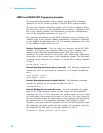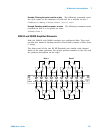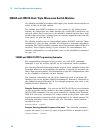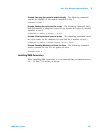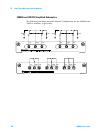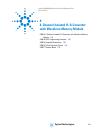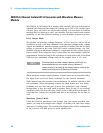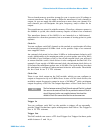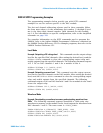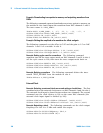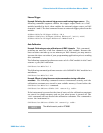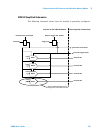
186 34980A User’s Guide
9 4-Channel Isolated D/A Converter with Waveform Memory Module
34951A 4-Channel Isolated D/A Converter with Waveform Memory
Module
The 34951A 4-Ch Isolated D/A module (DAC module) has four independent,
isolated DAC channels that output DC voltage up to ±16V or DC current up to
±20 mA. Since the DACs are electrically isolated, you can stack or combine
multiple DACs to have up to ±64 V on a module. You can control each channel
manually, or use the onboard memory to store multiple sequenced points.
Level Output Mode
The module can generate voltages between -16 V DC and +16 v DC at 500
µV
resolution on any or all four channels. Each channel configured for voltage
output has hardware remote- sensing capability to ensure that an accurate
voltage is present at the load. With the remote sensing feature, the DAC
channel outputs an additional voltage to compensate for the voltage drop in
the test leads. Thus, using the sense connections, the load voltage equals the
programmed voltage as long as the resistance in each sense lead is less than
2.5Ω and the maximum voltage drop in the output leads is 0.5 volts.
When using the remote-sensing feature, connect sense wires from the load to
the High Sense and Low Sense terminals for the desired channels.
Each channel can also generate current between -20 mA and +20 mA at 630
nA resolution. When outputting current the High Sense and Low Sense
terminals are not used and are opened. For protection, each channel
incorporates a fuse that will open at greater than 20 mA. If an overload
condition exists, the fuse will open, but no error or SRQ will be generated. To
reset the fuse, remove the overload and wait a few minutes for the fuse to
cool.
Waveform (Trace) Mode
Using the internal waveform point storage, you can output provided sine,
square, or ramp and triangle wave shapes, or define your own wave shape
with up to 512,000 points. The module can output points with a settling time
of 40
µs and a 200 kHz point-to-point update rate.
NOTE
To ensure that an accurate voltage is present at the loads, it is
recommended that you use remote-sensing. However, if
remote-sensing is not used, do not connect loads or cables to the
remote-sensing terminals (H Sense and L Sense).



